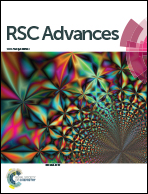Sensitive colorimetric detection of glucose and cholesterol by using Au@Ag core–shell nanoparticles†
Abstract
Glucose and cholesterol in human fluids are clinically important analytes and their sensitive detection is significant in diagnosis. In this study, Au@Ag core–shell nanoparticles (Au@Ag NPs) prepared by in situ growth of silver nanoparticles (AgNPs) on the surface of thiol-PEG-capped gold nanoparticles (AuNPs, 13 nm) have been successfully applied to fabricate a colorimetric biosensing platform for glucose and cholesterol. Au@Ag NPs showed an obvious absorbance peak at 375 nm due to the surface plasmon resonance (SPR) absorption of AgNPs. In the presence of cholesterol and glucose, H2O2 was produced under the catalytic action of their corresponding enzymes such as glucose oxidase (GOx) or cholesterol oxidase (ChOx), which etched the AgNPs shell of Au@Ag NPs. As a result, their characteristic absorbance at 375 nm decreased, accompanied with a perceptible color change from orange to red, which could be used to detect glucose and cholesterol by the naked eye. Under optimum conditions, the linear ranges for the detection of glucose and cholesterol by UV-vis spectroscopy were from 0.5 to 400 μM and 0.3 to 300 μM, respectively. The detection limit of the biosensors for glucose and cholesterol were 0.24 μM and 0.15 μM, respectively. The practical applications of this method in urine or human serum have been realized with satisfactory results. This work provides a simple and sensitive approach for glucose and cholesterol detection, which has broad application prospects in clinical diagnosis.


 Please wait while we load your content...
Please wait while we load your content...